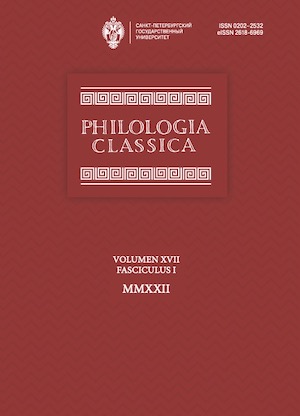Reflections on the Hesychian Lemma βουρικυπάρισσος
DOI:
https://doi.org/10.21638/spbu20.2022.105Аннотация
The Greek grammarian and lexicographer, Hesychius of Alexandria (5th–6th c. CE) included a Pamphylian gloss: βουρικυπάρισσος ἡ ἄμπελος. Περγαῖοι in his dictionary of rare and dialectal words. Based on a microphilological and lexical analysis, I suggest that the Greek text should be read as follows: βουρί˙κυπάρισσος ἢ ἄμπελος. Περγαῖοι (“bourí: cypress or grapevine. Citizens of Perge”). The Pamphylian gloss in question represents two different borrowings of terms originating in the Near East. The first item βουρί˙κυπάρισσος (‘cypress’) seems to have been borrowed from Akkadian burāšu(m) ‘a kind of conifer tree; juniper or cypress’ with a Lycian intermediary (Akk. burāšu → Luw. *burašiš > Lyc. *burehi > *burhi → Pamph. βουρί), whereas the second one βουρί˙ […] ἄμπελος (‘grapevine’) reflects a separate loanword from an Anatolian source, cf. Hitt. and Luw. muriš c. ‘a grapevine, a vine, a cluster or bunch of grapes or other fruit’. The Pamphylian dialect of Ancient Greek represents an extraordinary idiom, which was used in the neighbourhood of numerous Anatolian languages such as Lycian, Milyan, Sidetic, Pisidian and Cilician. It is therefore not surprising that the Pamphylian Greeks borrowed a number of cultural terms for plants from an Anatolian Indo-European source, as well as from Akkadian or other West Semitic languages via Luwian and Lycian. Additionally, other possible Anatolian borrowings into Ancient Greek (e. g. Gk. dial. βωληνή ‘a type of grapevine’, μῶλαξ ‘id.’ vs. Hittite maḫlaš c. ‘grapevine, Vitis vinifera L.’) are mentioned and reviewed.
Ключевые слова:
Hesychius’ lexicon, Ancient Greek, Pamphylian dialect, Anatolian borrowings, language contacts, Egyptian, Semitic loanwords
Скачивания
Библиографические ссылки
Загрузки
Опубликован
Как цитировать
Выпуск
Раздел
Лицензия
Статьи журнала «Philologia Classica» находятся в открытом доступе и распространяются в соответствии с условиями Лицензионного Договора с Санкт-Петербургским государственным университетом, который бесплатно предоставляет авторам неограниченное распространение и самостоятельное архивирование.






